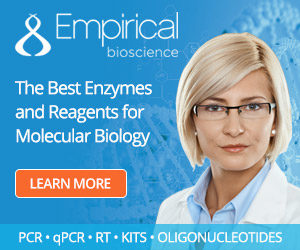FAQs
Order & Shipment
How long will it take to make my oligos?
Sequencing and PCR primers that are about 30 bases in length, and require no additional purification beyond gel filtration (GF) are usually ready to ship within 48 hours after receiving the order.
How are our products shipped?
Our products are shipped dry. Oligos are most stable in this form. Our products are shipped by overnight courier.
What scale of synthesis (20nmol, 50 nmol, 200 nmol, 1.0 umol, or larger) do I need to order?
For unmodified sequence with an approximately equal distribution of all 4 bases, and less than 35 bases in length, the expected yield for gel filtration (GF) grade material is typically 40 – 50% of the starting scale. For instance, a 200 nmol scale synthesis typically yields 80 – 100 nmoles of GF grade material. For sequence outside of these parameters, or those that require additional purification, contact Empirical’s Technical Service @ 877.479.9949 with your question.
Quality
Why does my HPLC elution profile have more than one peak?
During the process of purifying the oligo, the full-length oligo is separated from the shorter, failed sequences generated during the chemical synthesis.
Why does my mass spectrum have a peak at approximately half of the calculated molecular weight?
Our products are analyzed by delayed-extraction (DE) matrix assisted laser desorption/ionization (MALDI) time-of-flight (TOF) mass spectrometry. Ideally the laser creates a single ionic charge per molecule, but in reality it can generate a molecule with two negative charges. Since the mass spectrometer actually measures the mass-to-charge ratio of a molecule, the molecules having 2 charges will migrate up the tube to the detector in half the time it takes the singularly ionized molecule of the same mass. This phenomenon creates a peak with a mass that is almost exactly half the expected mass for the molecule.
Do my oligos contain any salt?
Our products have been purified from any extraneous salt; however, since DNA is anionic in nature, the counter ion will be either NH4+ or Na+ as expressed on the Certificate of Analysis.
Quantitation
What is an OD unit?
One OD unit, or A260 unit is that quantity of material which, when dissolved in 1.0 mL of water, and read in a spectrophotometer at 260 nm in a cuvette with a 1.0 cm light path, gives an absorbance of 1.0. An OD unit is roughly equivalent to 30 to 35 µg of DNA.
How does Empirical convert OD units to nmol?
The number of nanomoles is determined by dividing the total number of OD units by the molar extinction coefficient for the oligo as determined from the base composition of the sequence.
Dividing the number of OD units by the length of the oligonucleotide, and multiplying this quotient by 100 can give a quick approximation for the number of nmol.
I have received more than one vial for a particular sequence, is the quantity expressed on the label the total yield, or the amount in the individual vial?
The quantities expressed on the vial, whether it is the number of OD units, ug, or nmol, is always the amount that is in that particular vial while the amounts expressed on the Certificate of Analysis reflect the total amount of material in all the vials.
Storage & Use
What is the best way to store my oligos?
Oligos that are dry are very stable, and may be stored at room temperature, though -20°C is preferred. Oligos that are in solution need to be stored at -20°C.
Oligos that contain dyes should be protected from light.
What is an easy way to calculate the amount of solution needed to have the oligo at a concentration of 100 mM?
Multiply the number of nanomoles listed on the label or Certificate of Analysis by 10. This product is the number of µL of water or buffer that needs to be added to the oligo to obtain a 100mM solution.


